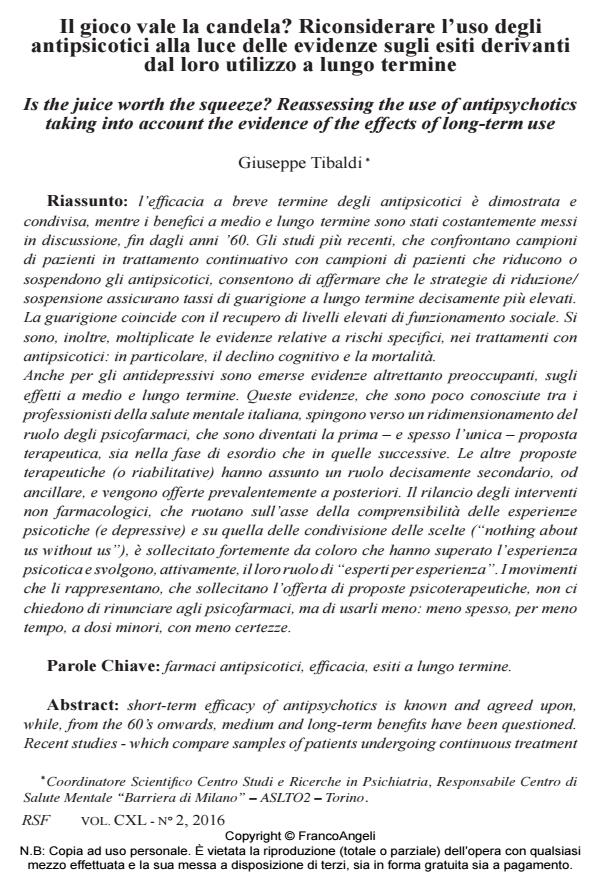Il gioco vale la candela? Riconsiderare l’uso degli antipsicotici alla luce delle evidenze sugli esiti derivanti dal loro utilizzo a lungo termine
Titolo Rivista RIVISTA SPERIMENTALE DI FRENIATRIA
Autori/Curatori Giuseppe Tibaldi
Anno di pubblicazione 2016 Fascicolo 2016/2
Lingua Italiano Numero pagine 21 P. 43-63 Dimensione file 223 KB
DOI 10.3280/RSF2016-002004
Il DOI è il codice a barre della proprietà intellettuale: per saperne di più
clicca qui
Qui sotto puoi vedere in anteprima la prima pagina di questo articolo.
Se questo articolo ti interessa, lo puoi acquistare (e scaricare in formato pdf) seguendo le facili indicazioni per acquistare il download credit. Acquista Download Credits per scaricare questo Articolo in formato PDF

FrancoAngeli è membro della Publishers International Linking Association, Inc (PILA)associazione indipendente e non profit per facilitare (attraverso i servizi tecnologici implementati da CrossRef.org) l’accesso degli studiosi ai contenuti digitali nelle pubblicazioni professionali e scientifiche
L’efficacia a breve termine degli antipsicotici è dimostrata e condivisa, mentre i benefici a medio e lungo termine sono stati costantemente messi in discussione, fin dagli anni ’60. Gli studi più recenti, che confrontano campioni di pazienti in trattamento continuativo con campioni di pazienti che riducono o sospendono gli antipsicotici, consentono di affermare che le strategie di riduzione/ sospensione assicurano tassi di guarigione a lungo termine decisamente più elevati. La guarigione coincide con il recupero di livelli elevati di funzionamento sociale. Si sono, inoltre, moltiplicate le evidenze relative a rischi specifici, nei trattamenti con antipsicotici: in particolare, il declino cognitivo e la mortalità. Anche per gli antidepressivi sono emerse evidenze altrettanto preoccupanti, sugli effetti a medio e lungo termine. Queste evidenze, che sono poco conosciute tra i professionisti della salute mentale italiana, spingono verso un ridimensionamento del ruolo degli psicofarmaci, che sono diventati la prima - e spesso l’unica - proposta terapeutica, sia nella fase di esordio che in quelle successive. Le altre proposte terapeutiche (o riabilitative) hanno assunto un ruolo decisamente secondario, od ancillare, e vengono offerte prevalentemente a posteriori. Il rilancio degli interventi non farmacologici, che ruotano sull’asse della comprensibilità delle esperienze psicotiche (e depressive) e su quella delle condivisione delle scelte ("nothing about us without us"), è sollecitato fortemente da coloro che hanno superato l’esperienza psicotica e svolgono, attivamente, il loro ruolo di "esperti per esperienza". I movimenti che li rappresentano, che sollecitano l’offerta di proposte psicoterapeutiche, non ci chiedono di rinunciare agli psicofarmaci, ma di usarli meno: meno spesso, per meno tempo, a dosi minori, con meno certezze.
Parole chiave:Farmaci antipsicotici, efficacia, esiti a lungo termine.
- Il contributo dei servizi ai processi di cronicizzazione. Quali ombre del manicomio gravano ancora sulle pratiche della "nostra" psichiatria di comunità? Giuseppe Tibaldi, in RIVISTA SPERIMENTALE DI FRENIATRIA 3/2018 pp.9
DOI: 10.3280/RSF2018-003002 - Hanno ucciso l’Uomo Ragno. Nascita, splendore, declino di una fase mitica della psicopatologia clinica e della psicoterapia. C’è ancora margine per una loro dignità scientifica? Una proposta connessionista complessa Miriam Gandolfi, in Ricerca Psicoanalitica /2022
DOI: 10.4081/rp.2022.608
Giuseppe Tibaldi, Il gioco vale la candela? Riconsiderare l’uso degli antipsicotici alla luce delle evidenze sugli esiti derivanti dal loro utilizzo a lungo termine in "RIVISTA SPERIMENTALE DI FRENIATRIA" 2/2016, pp 43-63, DOI: 10.3280/RSF2016-002004